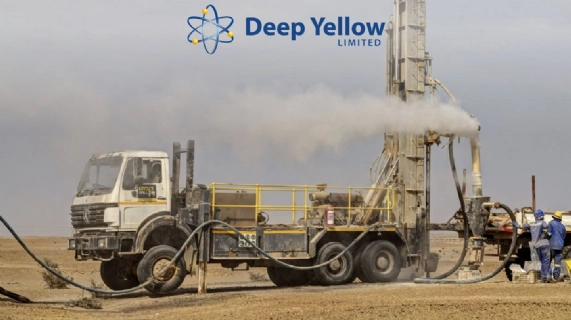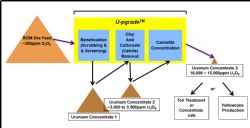
Tumas Project U-pgrade(TM) Further Update
Perth, June 3, 2016 AEST (ABN Newswire) - Advanced stage uranium explorer Deep Yellow Limited ( ASX:DYL) (
ASX:DYL) ( DYLLF:OTCMKTS) is pleased to provide a further update to its recently announced interim results from the metallurgical testwork program currently underway on bulk samples from the Company's Tumas Project located in Namibia.
DYLLF:OTCMKTS) is pleased to provide a further update to its recently announced interim results from the metallurgical testwork program currently underway on bulk samples from the Company's Tumas Project located in Namibia.
KEY POINTS
- The initial results show that application of Marenica's U-pgrade(TM) process to the Tumas bulk samples can effectively reject up to 98% of the mass and retain greater than 82% of the uranium.
- Indications are that a high grade concentrate in excess of 13,000 ppm U3O8 can be produced by application of the process to the 368 ppm U3O8 Tumas ore.
- Because of the significant mass reduction, a project incorporating the beneficiation process as an integral part of the overall flowsheet has the potential to have comparatively low capital and operating costs and an accelerated development timeline.
The tests are being conducted at the CSIRO and Nagrom Laboratories in Perth under the supervision of Marenica Energy Ltd (Marenica) and DYL's consulting metallurgist Mr Martin Errington.
DYL advised recently that the interim results were promising because they provided confidence that a high recovery of uranium can be achieved into a low mass, high grade concentrate. An explanation of the process follows to better illustrate the reasoning by DYL's technical team.
Metallurgical Testwork
The Company has been working with Marenica since late 2013 when the first tests were reported to shareholders (December Quarter Activities Report - 2 February 2014). Subsequently, a small infill drilling program and sophisticated geophysical modelling completed in 2015 provided confidence that the Tumas - Tubas Palaeochannel was sufficiently prospective to warrant further work.
Following this field work and after further engagement with Marenica, bulk samples were excavated from the Tumas Zone 1 resource area infill drilling area in December 2015 and January 2016.
The proposed metallurgical U-pgrade(TM) flowsheet, developed by Marenica, has a patent pending and DYL has executed a Confidentiality Agreement.
The process in its simplest form involves the physical beneficiation of the sample through two key stages before moving to concentrate the remaining uranium minerals.
As previously advised, mineralogical characterisation has shown that the primary uranium bearing mineral, carnotite, is liberated in the process. This conclusion can be drawn because of extensive mineralogical analysis completed by CSIRO on the feed sample and interim testwork products.
Calcrete ores such as Tumas are characterised by carbonate minerals and fine particulate material. The presence of carbonate minerals excludes the use of acid leaching due to the high acid consumption and thus the conventional approach is to leach these ore types with alkali, a high temperature, slow kinetics and relatively high cost process. The inclusion of fine particulate material in the ores produces materials handling issues, which result in higher operating costs and reduced uranium recovery.
Removal of carbonate minerals produces a concentrate with minimal acid consumers, a suitable feed for the faster kinetics, lower operating and capital cost acid leach process. Removal of the fine particulate material greatly improves the materials handling characteristics, which is a significant advantage for a beneficiation process and subsequent leach and solid/liquid separation stages.
The interim results determined that >95% of the carbonate minerals could be removed with a loss of <5% of the uranium. The de-sliming step rejected ~27% of the mass as fine particulate material with <7% of the uranium feeding the de-slime stage. These interim results have demonstrated that the critical carbonate and de-slime removal steps of the process do work on the Tumas samples provided, which is very encouraging. Application of the process will enable a significant reduction in the mass being handled with a minor loss of the primary mineral.
Testwork is continuing on further upgrading of the uranium into a low mass concentrate. Results to date indicate that a concentrate containing less than 3% of the ore feed mass, grading greater than 13,000 ppm U3O8 and containing greater than 82% of the uranium can be generated from the Tumas samples. through application of Marenica's U-pgrade(TM) process.
The final concentrate will be suitable for processing using conventional acid leaching and refining technology to produce yellowcake. Alternatively the concentrate produced may be safely and cost-effectively transported to third parties for final processing.
The Company has consistently sought opportunities to become a producer via a fast track, relatively low capex development strategy. The objective to develop an operation capable of cost effectively producing a high grade intermediate product for satellite supply to any one of the existing Namibian uranium mines appears to be a step closer and if the current testwork program is successful then the Company will be in a strong position to deliver on its strategy.
To view tables and figures, please visit:
http://abnnewswire.net/lnk/1HT709Z8
About Deep Yellow Limited
 Deep Yellow Limited (ASX:DYL) (OTCMKTS:DYLLF) is successfully progressing a dual-pillar growth strategy to establish a globally diversified, leading uranium company producing 10+ Mlb pa. The Company's portfolio consists of two advanced projects in Tier-1 uranium mining jurisdictions - flagship Tumas in Namibia and Mulga Rock, Western Australia.
Deep Yellow Limited (ASX:DYL) (OTCMKTS:DYLLF) is successfully progressing a dual-pillar growth strategy to establish a globally diversified, leading uranium company producing 10+ Mlb pa. The Company's portfolio consists of two advanced projects in Tier-1 uranium mining jurisdictions - flagship Tumas in Namibia and Mulga Rock, Western Australia.
Deep Yellow's future growth is underpinned by its highly prospective exploration portfolio - Alligator River, Northern Territory and Omahola, Namibia with ongoing M&A focused on high quality assets should opportunities arise that best fit the Company's strategy. Led by a best-in-class team, who are proven uranium mine builders and operators, the Company is advancing its growth strategy at a time when the need for nuclear energy is becoming the only viable option in the mid-to-long-term to provide baseload power supply and achieve zero emission targets. Importantly, Deep Yellow is on track to becoming a reliable and long-term uranium producer, able to provide production optionality, security of supply and geographic diversity.
| ||
|














